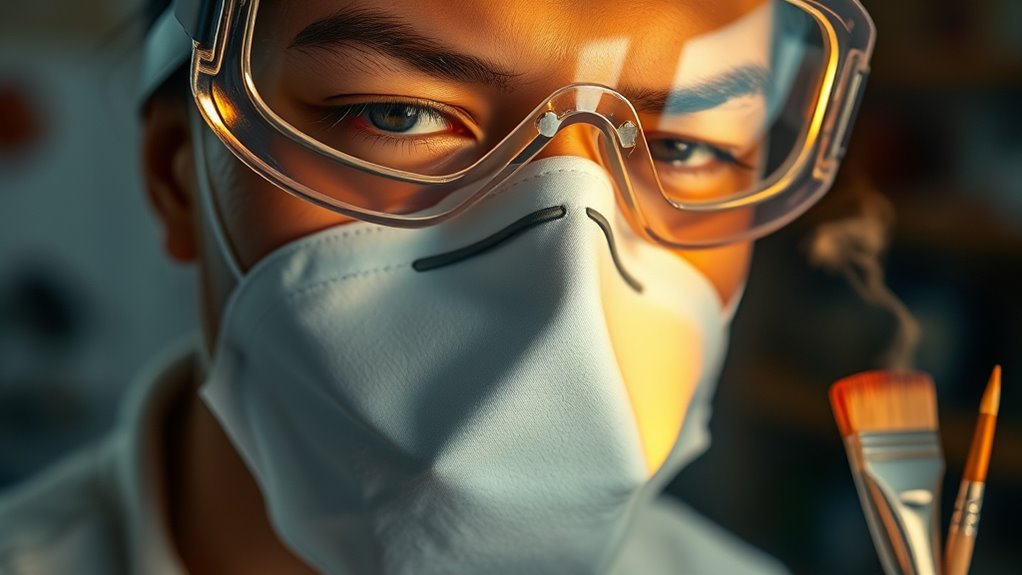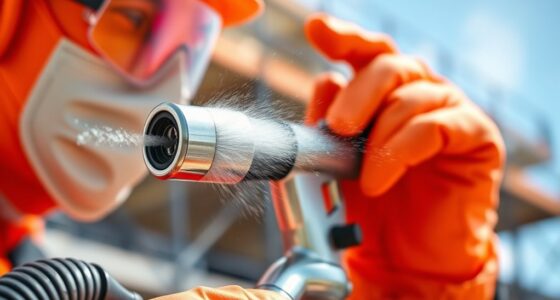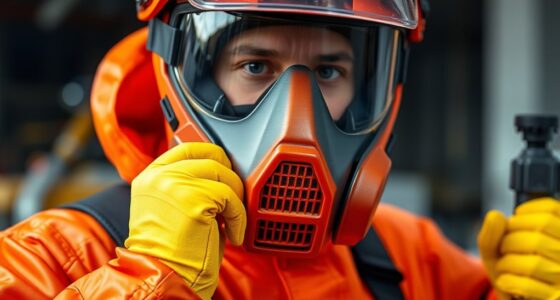If you notice sudden headaches, dizziness, or eye irritation after painting, it’s a sign of fume overexposure. You might also feel nausea, fatigue, or difficulty breathing, which indicates your body is reacting to harmful fumes. Skin rashes or a change in your sense of smell can also appear early. Paying attention to these signs helps you act quickly—keep going, and you’ll discover more ways to protect yourself.
Key Takeaways
- Watch for unexplained headaches, dizziness, and eye irritation indicating early VOC overexposure.
- Notice respiratory symptoms like coughing, sore throat, or difficulty breathing in poorly ventilated areas.
- Be alert to sudden eye redness, burning sensations, or blurred vision as signs of fume irritation.
- Recognize systemic signs such as nausea, fatigue, or chest tightness that suggest inhalation of toxic fumes.
- Monitor for skin reactions like redness or rashes, and track symptom progression to prevent long-term health issues.
Unexplained Headaches and Dizziness
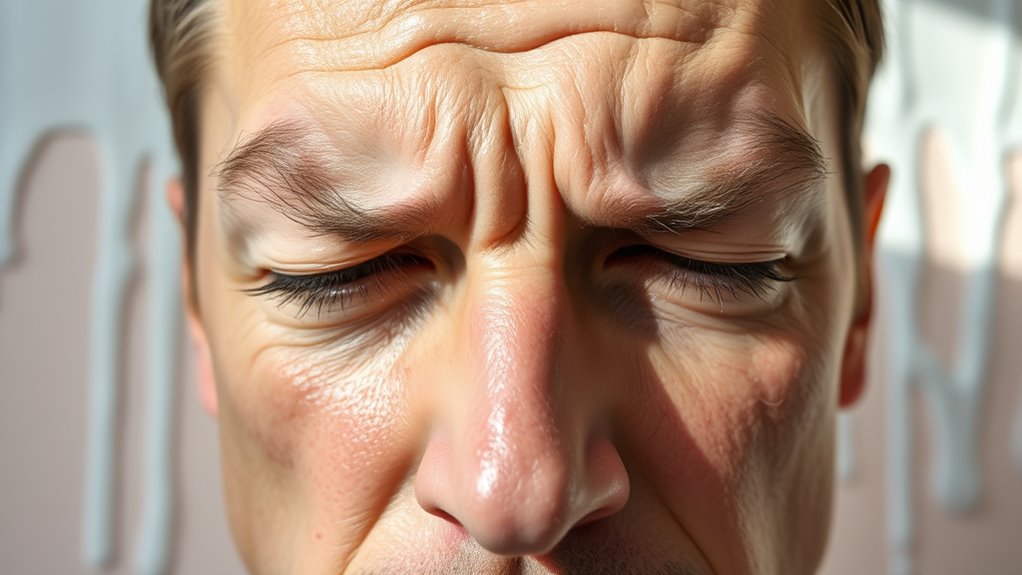
Unexplained headaches and dizziness are often among the earliest signs that you’re overexposed to paint fumes. Poor indoor air quality caused by lingering paint fumes can quickly affect your health, especially if ventilation is inadequate. As you spend time in a freshly painted room, you might notice a pounding headache or a feeling of lightheadedness without any obvious reason. These symptoms occur because paint fumes contain volatile organic compounds (VOCs) that can irritate your nervous system. If you experience these signs, it’s a clear indication that your indoor air quality needs improvement. Proper ventilation is essential to reduce VOC buildup and protect your health. Ignoring these symptoms can lead to more serious health issues, so it’s vital to step outside or increase ventilation as soon as you feel unwell.
Respiratory Irritation and Coughing
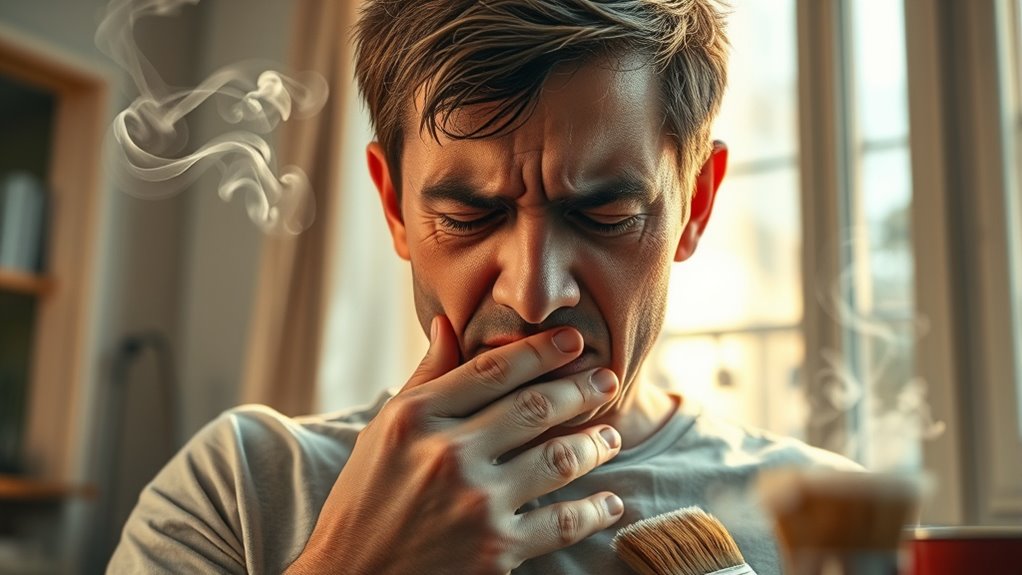
When overexposure to paint fumes occurs, your respiratory system often becomes irritated, leading to persistent coughing and sore throat. You might notice increased wheezing or difficulty breathing, especially in poorly ventilated areas. To reduce these symptoms, air quality monitoring can help identify high concentrations of fumes, alerting you to take action. Proper ventilation practices are vital—open windows, use exhaust fans, or wear respirators to improve airflow and dilute airborne chemicals. Mindfulness techniques such as breathing exercises can also help manage discomfort and promote relaxation during exposure. Recognizing air quality levels through monitoring is essential, as poor air quality can significantly impact respiratory health. Understanding airborne chemicals and their effects can aid in better managing exposure risks. Ignoring these signs can worsen irritation or cause more serious respiratory issues over time. Regularly checking air quality and maintaining good ventilation practices can considerably minimize your exposure. If symptoms persist despite these measures, seek fresh air immediately and consult a healthcare professional for further evaluation.
Sudden Eye Redness or Burning Sensation
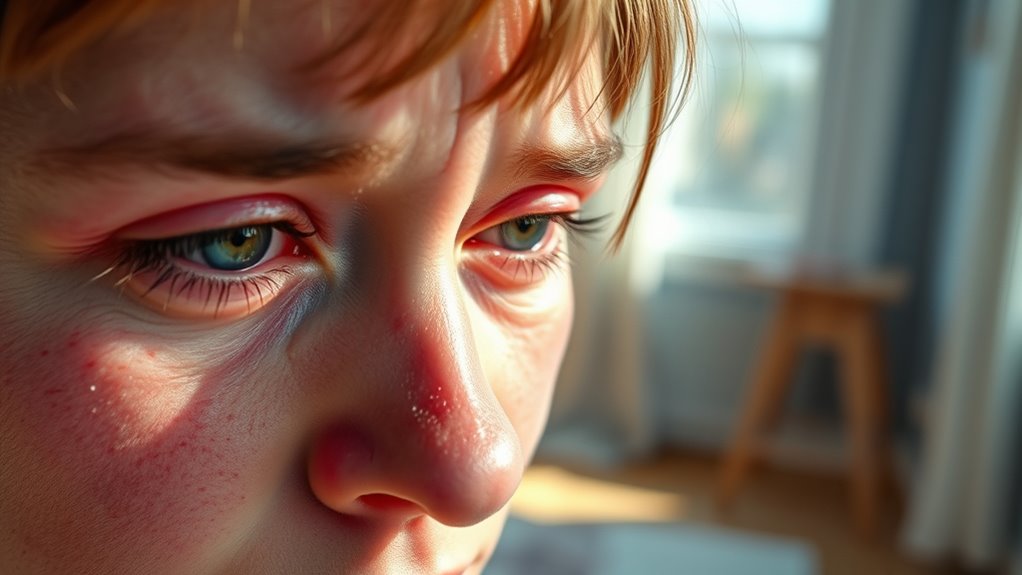
Overexposure to paint fumes doesn’t just affect your respiratory system—it can also cause immediate issues with your eyes. You might notice eye irritation, such as redness, dryness, or a burning sensation. These symptoms happen because fumes contain volatile chemicals that irritate the delicate tissues of your eyes. You may experience a sudden burning sensation or a feeling of grit or foreign body in your eyes. In some cases, redness becomes prominent, and your vision might temporarily seem blurry or altered. Eye irritation causes can be exacerbated by prolonged exposure without proper ventilation. Interestingly, AI safety measures, such as real-time monitoring of AI outputs, are essential to prevent unintended harmful consequences in automated systems. Recognizing the importance of industry transformations can help you understand how technological advancements impact safety protocols and environmental health. Ignoring these signs can lead to more severe eye discomfort or damage. If you notice sudden eye redness or burning, it’s essential to move to a well-ventilated area and rinse your eyes with clean water. Prompt action helps prevent further irritation or potential vision changes. Additionally, understanding paint fume hazards can help you take better precautions in the future, especially since data analytics in AI can identify environmental risks and improve safety protocols.
Nausea and Gastrointestinal Discomfort

As paint fumes seep into your environment, you might start feeling nauseous or experience stomach discomfort, signaling that your body is reacting to the chemicals. These gastrointestinal symptoms are common early signs of overexposure. You may notice a queasy feeling, stomach cramps, or an upset stomach shortly after exposure. Paint fumes contain volatile organic compounds (VOCs) that can irritate your digestive system, leading to these symptoms. Overlooking them can worsen your condition or indicate that the fumes are reaching dangerous levels. If you experience nausea or stomach discomfort, it’s essential to step into fresh air immediately and ventilate the area. Recognizing these signs early helps prevent further health issues and ensures you respond promptly to minimize exposure. Being aware of paint fume hazards is crucial for maintaining your health during painting projects. Additionally, understanding the chemical composition of VOCs can help you better assess the risks involved and take appropriate precautions. Furthermore, implementing effective ventilation strategies can significantly reduce the impact of fumes in your environment.
Fatigue and General Weakness

Experiencing persistent fatigue and a general sense of weakness can be early indicators that paint fumes are affecting your body. You might notice that your energy drops quickly, even after a full night’s rest, or that you feel unusually drained during work. This occupational fatigue isn’t just normal tiredness; it’s a sign your body is reacting to chemical exposure. Work-related exhaustion can intensify, making simple tasks feel formidable. If you find yourself lacking motivation or feeling physically weak without clear cause, it could be linked to inhaling fumes. Recognizing this early allows you to take action, such as improving protective styling ventilation or seeking medical advice. Staying informed about digital literacy and safety measures can help you better understand and manage exposure risks in environments with paint fumes. Ignoring these signs might lead to more serious health issues over time, so stay alert to your body’s signals.
Shortness of Breath or Chest Tightness

If you notice difficulty breathing or a feeling of tightness in your chest, it’s essential to recognize these as potential signs of paint fume overexposure. Pay attention to any chest discomfort and how it changes over time. Monitoring your symptoms closely can help determine if you need immediate medical attention. Using appropriate protective measures, like wearing the right earplugs at loud events, can also prevent further health issues. Being aware of symptoms related to sensory stimulation can aid in early detection of overexposure and prompt necessary actions. Additionally, understanding the physical changes that occur during pregnancy can help identify unusual reactions to environmental factors like fumes.
Recognize Breathing Difficulties
Breathing difficulties are a clear sign that your body is struggling to handle paint fumes. You might notice irregular respiration patterns, such as rapid or shallow breaths, indicating your lungs are working harder than usual. Your breathing rate could increase, making you feel short of breath even during minimal activity. Conversely, you might experience a slower rate, accompanied by feelings of tightness in your chest. These signs suggest your lungs are reacting negatively to the fumes, and your body is trying to compensate. Pay close attention to how you breathe—any irregularity or effort should prompt immediate action. Recognizing these breathing difficulties early helps prevent more serious health issues and signals that you need fresh air or medical attention. Monitoring respiratory health is essential when working with potentially hazardous fumes to prevent long-term damage. Being aware of symptoms of overexposure can help you respond promptly and seek appropriate care. Additionally, understanding support hours for assistance can be crucial if you experience severe symptoms and need urgent help.
Identify Chest Discomfort Signs
Chest discomfort from paint fume overexposure often manifests as shortness of breath or a feeling of tightness in the chest. If you notice these signs, check your paint ventilation setup. Poor ventilation increases your risk of fume exposure, intensifying chest symptoms. You might feel as if your chest is constricted or struggle to breathe deeply. These sensations can occur quickly, especially in enclosed spaces with inadequate airflow. Pay attention to how your chest feels during or after painting. Promptly improving ventilation or leaving the area can help alleviate discomfort. Recognizing these early signs allows you to respond before symptoms worsen. Protect yourself by ensuring proper paint ventilation and avoiding prolonged exposure to fumes, which can exacerbate chest tightness and other health issues.
Monitor Symptom Progression
Monitoring how your symptoms change over time is essential in recognizing paint fume overexposure. By actively engaging in symptom tracking, you can notice patterns or worsening signs like shortness of breath or chest tightness. Keep a detailed record of when symptoms occur, their severity, and any triggers. Regular health monitoring helps you identify if your condition is improving or deteriorating, prompting timely action. If your symptoms intensify or persist despite reducing exposure, seek medical attention immediately. Tracking your symptoms provides valuable information for healthcare providers and ensures you don’t overlook subtle changes. Staying vigilant with health monitoring empowers you to respond quickly and avoid serious complications from paint fume overexposure. Advances in natural language processing also enable more accurate symptom analysis through digital health tools, further supporting early detection.
Altered Sense of Smell or Taste

If you notice your sense of smell or taste becoming distorted or dulled after working with paint fumes, it could be a sign of overexposure. This olfactory dysfunction, or altered sense of smell, indicates your nervous system may be affected by toxic fumes. Similarly, taste alteration can occur, making food and drinks seem off or flavorless. These changes often happen early and can be subtle, but they shouldn’t be ignored. Over time, continued exposure may worsen these symptoms or lead to more serious health issues. If you experience a persistent loss or change in smell or taste, it’s vital to ventilate the area immediately and seek medical advice. Recognizing these early signs helps prevent further damage and guarantees your safety.
Skin Irritation or Rashes
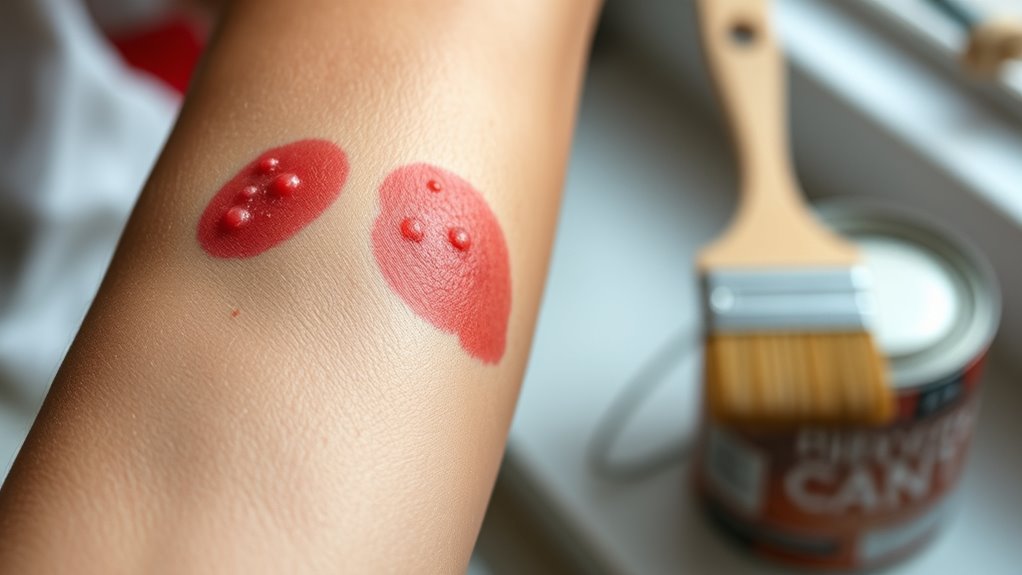
You might notice redness and itching on your skin after exposure to paint fumes. Rashes can develop in patterns that indicate contact with certain areas or materials. Pay attention to where your skin feels irritated most, as this can help identify the source of overexposure.
Skin Redness and Itching
Skin redness and itching are common early signs of paint fume overexposure, signaling that your skin has come into contact with harmful chemicals. Your skin’s response may be intensified by paint absorption and inherent skin sensitivity, making you more prone to irritation. Recognizing these signs early helps prevent further damage.
- Your skin may develop localized redness, indicating inflammation from chemical contact.
- Itching suggests your immune system is reacting to irritants.
- Prolonged exposure can lead to increased sensitivity and worsening symptoms.
- Using protective gear minimizes direct contact and reduces absorption.
- Regular skin checks help catch overexposure before symptoms escalate, ensuring prompt action.
Rash Development Patterns
Rash development patterns often reveal how your skin responds to paint fumes over time. Recognizing these paint skin reactions helps you identify overexposure early. You might notice rashes appearing in specific areas, such as the face, neck, or hands, where paint fumes contact your skin directly. The rash pattern recognition can show whether the irritation is localized or spreading, indicating your body’s reaction intensity. Some people develop small, red bumps, while others experience larger, inflamed patches. These patterns can evolve quickly, signaling the need to step away from the fumes and seek fresh air. By paying close attention to how and where the rash develops, you can catch paint fume overexposure early and prevent more severe skin reactions.
Contact Areas Affected
When exposed to paint fumes, the areas most likely to develop irritation or rashes are those directly in contact with the fumes or residue. These spots often experience surface irritation due to prolonged or repeated paint contact. You might notice redness, swelling, or itching on your skin where paint has touched. Pay close attention to your hands, arms, face, neck, and any exposed areas. Surface irritation from paint contact can worsen if left untreated, leading to more discomfort or potential skin infections. Recognizing these signs early helps prevent further skin damage. Be cautious about areas that frequently come into contact with paint fumes, and always wash exposed skin promptly. Proper protective gear minimizes contact and reduces the risk of skin irritation or rashes developing.
Frequently Asked Questions
How Quickly Can Symptoms of Paint Fume Overexposure Develop?
The paint fume symptoms can develop quickly, often within minutes to a few hours after exposure. The exposure timeline varies depending on the fumes’ concentration and your sensitivity. You might notice dizziness, headaches, or nausea early on, signaling overexposure. It’s important to recognize these signs promptly, as delaying action can worsen your condition. Always guarantee proper ventilation and protective gear to minimize risks during painting projects.
Are There Long-Term Health Risks From Repeated Paint Fume Exposure?
Think of repeated paint fume exposure like slowly filling a leaky bucket—you might not notice the damage right away. Long-term effects can include chronic health issues like respiratory problems or neurological effects. Regular exposure increases risks over time, so it’s vital to ventilate well and wear protective gear. Ignoring these risks can lead to serious, lasting health consequences, emphasizing the importance of safety measures for long-term health.
Can Certain Individuals Be More Sensitive to Paint Fumes Than Others?
You might be more sensitive to paint fumes if you have individual sensitivities or allergy reactions. Some people naturally react more strongly to airborne chemicals, experiencing symptoms like headaches, dizziness, or respiratory issues sooner than others. Your health history and existing allergies can make you more prone to these effects. It’s important to take precautions, like ensuring proper ventilation and wearing protective gear, to reduce your risk of overexposure.
What Immediate Steps Should I Take if I Suspect Overexposure?
If you suspect overexposure to paint fumes, act quickly with first aid and emergency response. Move to fresh air immediately, ensuring good ventilation. If symptoms like dizziness, headache, or nausea occur, sit or lie down and stay hydrated. Call emergency services if symptoms worsen or persist. Stay calm, monitor your condition closely, and seek medical help promptly to prevent serious health complications.
How Can I Prevent Overexposure During Painting Projects?
You can’t afford to let paint fumes turn your project into a health hazard! Use effective ventilation strategies—like opening windows, using fans, and creating airflow—to keep fumes out of your lungs. Always wear protective gear such as masks, goggles, and gloves to shield yourself. By taking these simple steps, you guarantee a safer painting environment, preventing overexposure and keeping your health intact while you work.
Conclusion
If you notice symptoms like headaches, dizziness, or eye irritation after working with paint, don’t ignore them. Studies show that over 20% of painters experience early signs of fumes within their first year. Recognizing these symptoms early can prevent serious health issues down the line. Always guarantee proper ventilation and protective gear. Your health matters—stay alert to the signs of paint fume overexposure to keep yourself safe and healthy.
